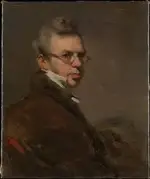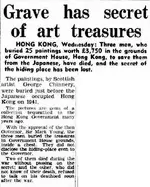Hello Jeff thanks once again for an interesting post. You be happy to know the paintings was not a cover story for some thing else. It was recovered. They was part of collection of an artist by the name of George Chinnery who was born in 5 January 1774 – 30 May 1852) was an English painter who spent most of his life in Asia, especially India and southern China.

From 1825 until his death in 1852 Chinnery based himself in Macau, but until 1832 he made regular visits to Canton (now Guangzhou). He painted portraits of Chinese and Western merchants, visiting sea-captains, and their families resident in Macau. His work in oil paint was closely imitated by the Cantonese artist Lam Qua, who himself became a renowned portrait painter. Chinnery also painted landscapes (both in oils and in watercolours), and made numerous drawings of the people of Macau engaged in their daily activities.
In 1846 he made a six-month visit to Hong Kong, where he suffered from ill health but made detailed studies of the newly founded colony. He died in Macau on 30 May 1852 and is buried in the Old Protestant Cemetery there.
Other than artistic value, his paintings are historically valuable as he was the only western painter resident in South China between the early and mid 19th century. He vividly depicted the life of ordinary people and the landscape of the Pearl River Delta at that period. Among the subjects of his portraits are the Scottish opium traders William Jardine and James Matheson as well as the diarist Harriet Low.
There is some more detail in the following story.Argus (Melbourne, Vic. : 1848 - 1957), Thursday 15 June 1950, page 21.

So Uglymailman sadly the mail has been mixed up with this one. The Hongkong painting story is totally different from The Philippine corrigador story which is a fantastic story in its own right.
Kanacki



